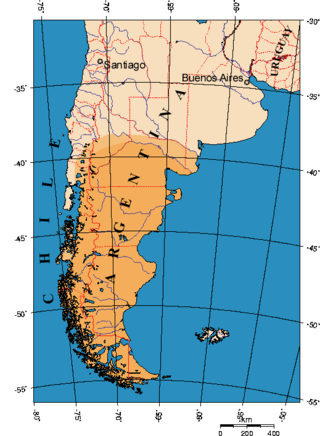
Patagonia is a geographical region that encompasses the southern end of South America, governed by Argentina and Chile. The region comprises the southern section of the Andes Mountains with lakes, fjords, temperate rainforests, and glaciers in the west and deserts, tablelands and steppes to the east. Patagonia is bounded by the Pacific Ocean on the west, the Atlantic Ocean to the east, and many bodies of water that connect them, such as the Strait of Magellan, the Beagle Channel, and the Drake Passage to the south.
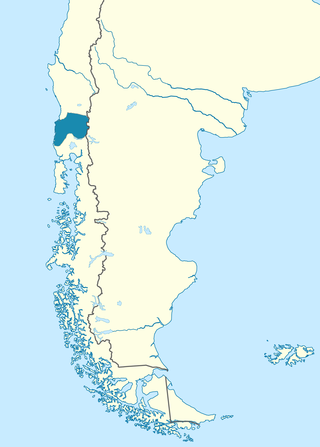
Huilliche is a moribund branch of the Araucanian language family. In 1982 it was spoken by about 2,000 ethnic Huilliche people in Chile, but now it is only spoken by a few elderly speakers. It is spoken in the nation's Los Lagos and Los Ríos regions; and mountain valleys, between the city of Valdivia and south toward the Chiloé Archipelago.

Mapuche ; from mapu 'land' and dungun 'speak, speech') is an Araucanian language related to Huilliche spoken in south-central Chile and west-central Argentina by the Mapuche people. It is also spelled Mapuzugun and Mapudungu. It was formerly known as Araucanian, the name given to the Mapuche by the Spaniards; the Mapuche avoid it as a remnant of Spanish colonialism.

The Mapuche is a group of native indigenous inhabitants of south-central Chile and southwestern Argentina, including parts of Patagonia. The collective term refers to a wide-ranging ethnicity composed of various groups who share a common social, religious, and economic structure, as well as a common linguistic heritage as Mapudungun speakers. Their homelands once extended from Choapa Valley to the Chiloé Archipelago and later spread eastward to Puelmapu, a land comprising part of the Argentine pampa and Patagonia. Today the collective group makes up over 80% of the indigenous peoples in Chile and about 9% of the total Chilean population. The Mapuche are concentrated in the Araucanía region. Many have migrated from rural areas to the cities of Santiago and Buenos Aires for economic opportunities.
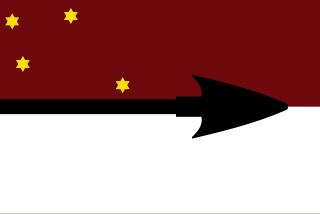
The Selk'nam, also known as the Onawo or Ona people, are an indigenous people in the Patagonian region of southern Argentina and Chile, including the Tierra del Fuego islands. They were one of the last native groups in South America to be encountered by migrant Europeans in the late 19th century. In the mid-19th century, there were about 4,000 Selk'nam; by 1919 there were 297, and by 1930 just over 100.

The Chonan languages are a family of indigenous American languages which were spoken in Tierra del Fuego and Patagonia. Two Chon languages are well attested: Selk'nam, spoken by the people of the same name who occupied territory in the northeast of Tierra del Fuego; and Tehuelche spoken by the people of the same name who occupied territory north of Tierra del Fuego. The name 'Chon', or Tshon, is a blend of 'Tehuelche' and 'Ona'.

Julius Popper, known in Spanish as Julio Popper, was a Romanian-born Argentine engineer, adventurer, and explorer. He was known as a modern "conquistador" of Tierra del Fuego in southern South America, and was both a controversial and influential figure. Popper was one of the main perpetrators of the genocide against the native Selk'nam people in the islands, and the circumstances surrounding his own death remain a mystery.

The Tehuelche people, also called the Aónikenk, are an indigenous people from eastern Patagonia in South America. In the 18th and 19th centuries the Tehuelche were influenced by Mapuche people, and many adopted a horseriding lifestyle. Once a nomadic people, the lands of the Tehuelche were colonized in the 19th century by Argentina and Chile, gradually disrupting their traditional economies. The establishment of large sheep farming estates in Patagonia was particularly detrimental to the Tehuelche. Contact with outsiders also brought in infectious diseases ushering deadly epidemics among Tehuelche tribes. Most existing members of the group currently reside in cities and towns of Argentine Patagonia.
Ona, also known as Selk'nam (Shelknam), is a language spoken by the Selk'nam people in Isla Grande de Tierra del Fuego in southernmost South America.

Fuegians are the indigenous inhabitants of Tierra del Fuego, at the southern tip of South America.

Spanish is the language that is predominantly understood and spoken as a first, or second language by nearly all of the population of Argentina. According to the latest estimations, the population is currently greater than 45 million.

Spanish is the de facto official and administrative language of Chile. It is spoken by 99.3% of the population in the form of Chilean Spanish, as well as Andean Spanish. Spanish in Chile is also referred to as "castellano". Although an officially recognized Hispanic language does not exist at the governmental level, the Constitution itself, as well as all official documents, are written in this language.
The Araucanization of Patagonia was the process of the expansion of Mapuche culture, influence, and its Mapudungun language from Araucanía across the Andes into the plains of Patagonia. Historians disagree over the time period during which the expansion took place, but estimate it occurred roughly between 1550 and 1850.
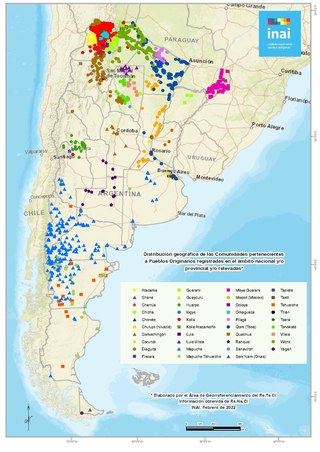
Argentina has 35 indigenous people groups officially recognized by the national government. As of the 2010 census [INDEC], some 955,032 Argentines self-identify as indigenous or first-generation descendants of indigenous peoples.
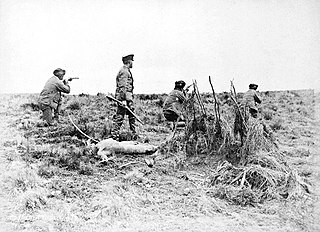
The Selk'nam genocide refers to the systematic extermination of the Selk'nam or Ona people, one of three indigenous tribes populating Tierra del Fuego in South America, from the second half of the 19th to the early 20th century. The genocide spanned a period of between ten and fifteen years. The Selk'nam had an estimated population of 4,000 people around the 1880s but saw their numbers reduced to 500 by the early 1900s.
The Haush language was an indigenous language spoken by the Haush people and was formerly spoken on the island of Tierra del Fuego. The Haush were considered the oldest inhabitants of Tierra del Fuego; they inhabited the far eastern tip of the Mitre Peninsula. They made regular hunting trips to Isla de los Estados.

Between 1883 and 1906 Tierra del Fuego experienced a gold rush attracting many Chileans, Argentines and Europeans to the archipelago, including many Dalmatians. The gold rush led to the formation of the first towns in the archipelago and fueled economic growth in Punta Arenas. After the gold rush was over, most gold miners left the archipelago, while the remaining settlers engaged in sheep farming and fishing. The rush made a major contribution to the genocide of the indigenous Selk'nam people.

Ramón Lista was an Argentinian soldier and explorer. He was the second governor of the Territorio Nacional de Santa Cruz, precursor of Santa Cruz Province, Argentina. He played a key role in the Selk'nam genocide in Tierra del Fuego. Later he identified with the indigenous people of Patagonia, and went to live with them until he was recalled to Buenos Aires. Lista wrote a number of books on the people and places he had found.

One of the best-known arts of the Mapuche is their textiles. The tradition of Mapuche textile production dates back to pre-Hispanic times and continues up to this day. Prior to the 20th century Mapuche textiles and ponchos in particular were important trade items.
















